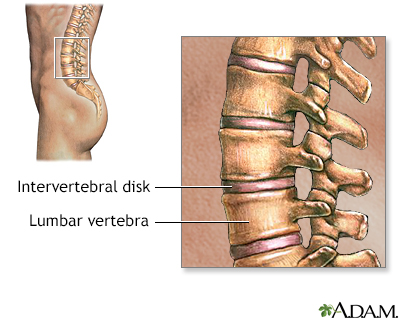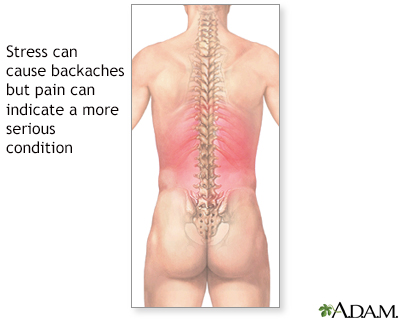Pregnancy SmartSiteTM
Backache; Low back pain; Lumbar pain; Pain - back; Acute back pain; Back pain - new; Back pain - short-term; Back strain - new DefinitionLow back pain refers to pain that you feel in your lower back. You may also have back stiffness, decreased movement of the lower back, and difficulty standing straight. Acute back pain can last for a few days to a few weeks. CausesMost people have at least one backache in their life. Although this pain or discomfort can happen anywhere in your back, the most common area affected is your lower back. This is because the lower back supports most of your body's weight. Low back pain is the number two reason that Americans see their health care provider. It is second only to colds and flu. You will usually first feel back pain just after you lift a heavy object, move suddenly, sit in one position for a long time, or have an injury or accident. Acute low back pain is most often caused by a sudden injury to the muscles and ligaments supporting the back. The pain may be caused by muscle spasms or a strain or tear in the muscles and ligaments. Causes of sudden low back pain include:
Low back pain may also be due to:
SymptomsYou may feel a variety of symptoms if you have hurt your back. You may have a tingling or burning sensation, a dull achy feeling, or sharp pain. The pain may be mild, or it can be so severe that you are unable to move. Depending on the cause of your back pain, you may also have pain in your leg, hip, or the bottom of your foot. You may also have weakness in your legs and feet. Exams and TestsWhen you first see your provider, you will be asked about your back pain, including its location, how often it happens and how severe it is. Your provider will try to determine the cause of your back pain and whether it is likely to quickly get better with simple measures such as ice, mild painkillers, physical therapy, and proper exercises. Most of the time, back pain will get better using these methods. During the physical exam, your provider will try to pinpoint the location of the pain and figure out how it affects your movement. Most people with back pain improve or recover within 4 to 6 weeks and often much sooner than that. Your provider may not order any tests of your spine during the first visit or for 4 to 6 weeks unless you have certain symptoms. Tests that might be ordered include:
TreatmentTo get better quickly, take the right measures when you first feel pain. Here are some tips for how to handle pain:
While sleeping, try lying in a curled-up, fetal position with a pillow between your legs. If you usually sleep on your back, place a pillow or rolled towel under your knees to relieve pressure. A common misbelief about back pain is that you need to rest and avoid activity for a long time. In fact, bed rest is not recommended. If you have no sign of a serious cause for your back pain (such as loss of bowel or bladder control, weakness, weight loss, or fever), then you should stay as active as possible. It is important to prevent your back and abdominal muscles from becoming too weak. You should reduce your activity only for the first couple of days. Then, slowly start your usual activities after that. Do not perform activities that involve heavy lifting or twisting of your back for the first 6 weeks after the pain begins. After 2 to 3 weeks, you should gradually start exercising again.
If your pain lasts longer than 1 month, your primary provider may send you to see a physiatrist (specialist in rehabilitation), or an orthopedist (bone specialist). If your pain has not improved after use of medicines, physical therapy, and other treatments, your provider may recommend an epidural injection. You may also see:
Sometimes, a few visits to these specialists will help back pain. Outlook (Prognosis)Many people feel better within 1 week. After another 4 to 6 weeks, the back pain should be completely gone. When to Contact a Medical ProfessionalContact your provider right away if you have:
Also contact your provider if:
PreventionThere are many things you can do to lower your chances of getting back pain. Exercise is important for preventing back pain. Through exercise you can:
It is also very important to learn to lift and bend properly. Follow these tips:
Other measures to prevent back pain include:
ReferencesCorwell BN, Davis NL. Back pain. In: Walls RM, ed. Rosen's Emergency Medicine: Concepts and Clinical Practice. 10th ed. Philadelphia, PA: Elsevier; 2023:chap 31. El Abd OH, Amadera JED. Low back strain or sprain. In: Frontera WR, Silver JK, Rizzo TD Jr, eds. Essentials of Physical Medicine and Rehabilitation: Musculoskeletal Disorders, Pain, and Rehabilitation. 4th ed. Philadelphia, PA: Elsevier; 2019:chap 48. Grabowski G, Gilbert TM, Larson EP, Cornett CA. Degenerative conditions of the cervical and thoracolumbar spine. In: Miller MD, Thompson SR, eds. DeLee, Drez, & Miller's Orthopaedic Sports Medicine. 5th ed. Philadelphia, PA: Elsevier; 2020:chap 130. Malik K, Nelson A. Overview of low back pain disorders. In: Benzon HT, Raja SN, Liu SS, Fishman SM, Cohen SP, eds. Essentials of Pain Medicine. 4th ed. Philadelphia, PA: Elsevier; 2018:chap 24. Murray EL, Misulis KE. Lower back and lower limb pain. In: Jankovic J, Mazziotta JC, Pomeroy SL, Newman NJ, eds. Bradley and Daroff's Neurology in Clinical Practice. 8th ed. Philadelphia, PA: Elsevier; 2022:chap 33. | ||
| ||
Review Date: 6/17/2024 Reviewed By: C. Benjamin Ma, MD, Professor, Chief, Sports Medicine and Shoulder Service, UCSF Department of Orthopaedic Surgery, San Francisco, CA. Also reviewed by David C. Dugdale, MD, Medical Director, Brenda Conaway, Editorial Director, and the A.D.A.M. Editorial team. View References The information provided herein should not be used during any medical emergency or for the diagnosis or treatment of any medical condition. A licensed medical professional should be consulted for diagnosis and treatment of any and all medical conditions. Links to other sites are provided for information only -- they do not constitute endorsements of those other sites. No warranty of any kind, either expressed or implied, is made as to the accuracy, reliability, timeliness, or correctness of any translations made by a third-party service of the information provided herein into any other language. © 1997- A.D.A.M., a business unit of Ebix, Inc. Any duplication or distribution of the information contained herein is strictly prohibited. | ||


 Lumbar vertebrae
Lumbar vertebrae Backaches
Backaches Sciatic nerve
Sciatic nerve Back pain - age fa...
Back pain - age fa... Herniated disk
Herniated disk
